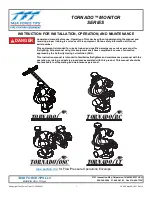
7-10
IM CA500-01EN
OD
Queries the measurement value
Command = OD(CrLf) → Return = abcde(CrLf)
Command = OD?(CrLf) → Return = abcde(CrLf)
Command = ODm(CrLf) → Return = abcde(CrLf)
Command = ODm?(CrLf) → Return = abcde(CrLf)
Parameters
m = 0: FUNCTION1
1: FUNCTION2
<Header section (4 bytes)>
a = V: Voltage
A: Current
O: Resistance
T: Temperature
F: Frequency
b = DC: DC
AC: AC
R2: Two-wire resistance measurement
R3: Three-wire resistance measurement
R4: Four-wire resistance measurement
c = N: Normal
O: Over range
E: No data
B: Burnout
<Data section (11 bytes)>
d = measurement value (8 digits)
e = E+0, E+3, E-3, E+6
For over range or burnout: de = 99999.E+3
For no data:
d = - - -.- - - (the decimal place is according to the set range)
e = E+0, E+3, E-3, E+6
If FUNCTION2 is set to TC measurement, the response to OD (CrLf) or OD?(CrLf) is a TC
measurement value. To receive the measurement value of Function 1, execute OD0 (CrLf).
If m is omitted, the measurement value of FUNCTION1 is output.
If FUNCTION2 is set to TC measurement, the response to OD (CrLf) or OD?(CrLf) is a TC
measurement value. To receive the measurement value of FUNCTION1, execute OD0 (CrLf).
OE
Queries the error information
Command = OE<CRLF> -> Return = ERRm<CRLF>
Outputs the most recent error.
After returning the error, the saved error number is overwritten with “ERR00<CRLF>.”
“ERR00<CRLF>” is returned when there is no error.
Parameters
m = Error code number
(See “Error Codes.”)
7.4 Commands













































